Disney Mythology vs. Greco-Roman Mythology: Part I Posted by Brittany Britanniae on Nov 19, 2014 in Roman culture
Salvete Omnes,
With the many of you learning Latin and the Roman culture; I believe it is important to observe how antiquity permeates through modern media. So today I propose we observe the role of mythology, mythic characters and items within Disney films and series.
#1. Character or Item FEMALE CENTAURS OR KENTAURIDES
Film or Series: Fantasia; 1940 & The Lion, The Witch, & The Wardrobe; 2005
Commentary: Female Centaurs are not really discussed at length within modern or even ancient mythology. When recalling recent films with centaurs (Harry Potter, Step- Brothers, Percy Jackson: The Lightning Thief), the centaurs are male. However that small amount of mythology which is discussed by ancient sources does reflect the imagery that Disney produces in these films (i.e.- beauty consumed creatures, but nobly warlike when they need to be).
Disney Mythology: Within Fantasia ( the video above) is from the chapter known as “The Pastoral Symphony” by Beethoven. The setting is a mythical world of centaurs, cupids, fauns and other figures from classical mythology. A gathering for a festival to honor Bacchus (Dionysus), the god of wine, is interrupted by Jupiter (Zeus), who creates a storm and throws lightning bolts at the attendees. The mythology of centaurs present in The Lion, The Witch, and The Wardrobe is that of C.S Lewis’ mythology (here)and not necessarily of Disney.
Greco-Roman Mythology: Though female centaurs, called Kentaurides, are not mentioned in early Greek literature and art, they do appear occasionally in later antiquity. A Macedonian mosaic of the 4th century BC is one of the earliest examples of the Centauress in art.
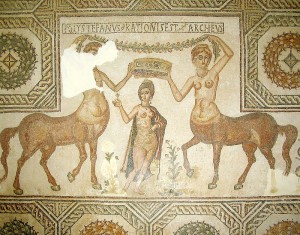
Female centaurs flanking Venus (Mosaic from Roman Tunisia, 2nd century AD).Courtesy of WikiCommons & GiorcesBardo55 .
Ovid’s “Metamorphoses” also mentions a Kentaurides named Hylonome who committed suicide when her husband Cyllarus was killed in the war with the Lapiths:
“In the high woods there was none comelier of all the centaur-girls, and she alone by love and love’s sweet words and winning ways held Cyllarus, yes, and the care she took to look her best (so far as that may be with limbs like that). She combed her glossy hair, and twined her curls in turn with rosemary or violets or roses, and sometimes she wore a pure white lily. Twice a day she bathed her face in the clear brook that fell from Pagasae’s high forest, twice she plunged her body in its flow, nor would she wear on her left side and shoulder any skin but what became her from best-chosen beasts.
#2. Character or Item: KING TRITON or TRITON
Film or Series: The Little Mermaid; 1989
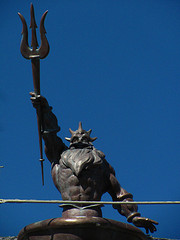
King Triton added to Ariel’s Undersea Adventure Building at Disneyland. Courtesy of Flickr and Loren Javier.
Commentary: King Triton often confused with Neptune (Poseidon) due to this Disney portrayal. Neptune is the king of the seas, but Triton is actually a son of Neptune. Ariel does not exist in any mythology.
Disney Mythology: King Triton is king of the sea and has a triton. He is a widower with seven daughter including Ariel who is the protagonist of the featured film “The Little Mermaid.” The film is based upon the Hans Christen Anderson’s fairy tale which is simply called “The Little Mermaid” and the stories are almost identical except for a few details: she has no name (simply known as the Little Mermaid), her legs hurt with excoriating pain, her prince does fall in love with her (but marries someone else), heartbroken she is given the choice to kill the prince (a become a mermaid again) or not, and lastly she throws herself into the sea unable to kill the prince and becomes foam and then an air spirit.
Greco-Roman Mythology: He is usually represented as a merman, having the upper body of a human and the tail of a fish, “sea-hued”, according to Ovid “his shoulders barnacled with sea-shells. According to Hesiod, Triton dwelt with his parents in a golden palace in the depths of the sea. He is said to have had one daughter , Pallas, who was killed by Minerva (Athena), who was a foster daughter or ward to him, in an innocent friendly fight.
Pausanias describes Triton(s) (the children and class of mermen/mermaids) as the following:
On their heads they grow hair like that of marsh frogs not only in color, but also in the impossibility of separating one hair from another. The rest of their body is rough with fine scales just as is the shark. Under their ears they have gills and a man’s nose; but the mouth is broader and the teeth are those of a beast. Their eyes seem to me blue, and they have hands, fingers, and nails like the shells of the murex. Under the breast and belly is a tail like a dolphin’s instead of feet
#3. Characters or Item PANTHEON of GODS
Film or Series: Hercules; 1997
Commentary: While the names of the Gods are from the Greek Mythology; Hercules is the Romanized version of Herakles. Furthermore, Mount Olympus would rarely house all the gods at one time for the birth of a god. There is no record of this ever taking place within mythology. Lastly, the entire film is based upon Hercules seeking to be a hero to regain his “godhood;” when in fact Hercules was never a god. He was also a demi-god and Hera was not his mother let alone loving towards him at all!
Disney Mythology: The birth day celebration of Hercules the god, who is the son of Juno (Hera) and Jupiter or Jove (Zeus). It features Neptune (Poseidon), Minerva (Athena), Jupiter (Zeus), Jove (Hera), Mars (Ares), Venus (Aphrodite), Vulcan (Hephaestus), Mercury (Hermes), Diana (Artemis), Bacchus (Dionysus), Sol (Helios), and more! The scene is filled with gods who are too obscure to see or who shouldn’t be considered a “god” (like Narcissus).
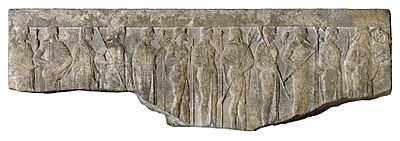
Fragment of a Hellenistic relief (1st century BC – 1st century AD) depicting the Twelve Olympians carrying their attributes in procession; from left to right, Hestia (scepter), Hermes (winged cap and staff), Aphrodite (veiled), Ares (helmet and spear), Demeter (scepter and wheat sheaf), Hephaestus (staff), Hera (scepter), Poseidon (trident), Athena (owl and helmet), Zeus (thunderbolt and staff), Artemis (bow and quiver), Apollo (lyre), from the Walters Art Museum. Courtesy of WikiCommons.
Greco-Roman Mythology: The gods would rarely been seen together, but the 12 Olympians would be seen as the hierchacial gods that would reign from Mount Olympus. The gods were known for fighting with another, taking sides in the affairs of mortals, and hardly being cordial or nice unless you were Jupiter or Jove (i.e. King of the Gods!). For more information on stories of the Greco-Roman Gods; check it out here.
#4. Characters or Items: MYTHOLOGICAL CROSSOVER
Films or Series: The Little Mermaid; 1989 & Hercules;1997
Commentary: This connection between Disney and Greco-Roman mythology was included merely for fun and humorous sake. Since Ariel is not a “real” or “true” mythological character- most of this means nothing.
Disney Mythology: The world of Disney (in films) does not remark of this correlation other than “memes” that fans have figured out and one conversation reported with two Disney actors:
Greco-Roman Mythology: According to Greek mythology, Ariel’s father, Triton, is the son of Poseidon, which would make the sea god Ariel’s grandfather. Poseidon’s brother Zeus is the father of Hercules, so Herc and Triton are first cousins. The child of your first cousin is your first cousin once removed, therefore Hercules and Ariel are first cousins once removed.
If this is still causing issues in the respect to “your mind is blown;” I have provided a helpful image of a family tree illustrating this (here). However, since Ariel does NOT exist then perhaps it is better said that King Triton and Hercules are related.
FINAL THOUGHTS
I do hope you enjoyed this! I have more similarities next week! Some of them are super obvious and others are bit harder to discern! Have an awesome weekend!
If you are interested in Part II of this Blog series- check it out here!

Build vocabulary, practice pronunciation, and more with Transparent Language Online. Available anytime, anywhere, on any device.
About the Author: Brittany Britanniae
Hello There! Please feel free to ask me anything about Latin Grammar, Syntax, or the Ancient World.



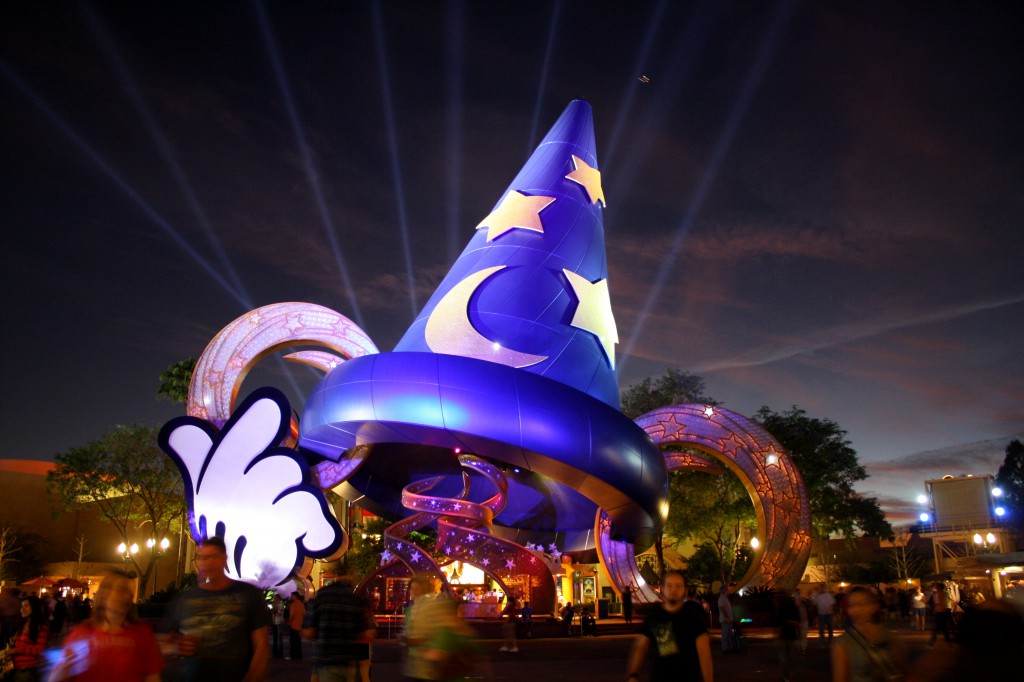
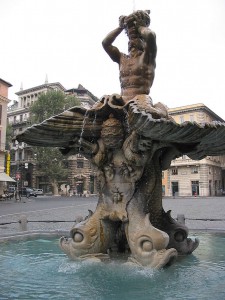

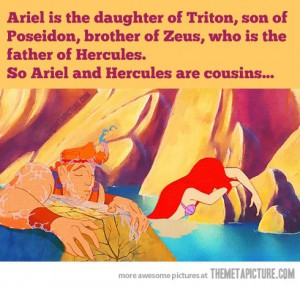

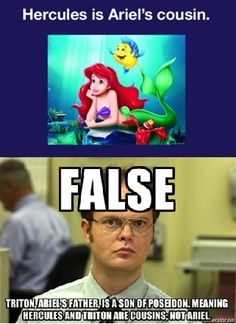

Comments:
Fiona:
Hi,
Thanks for an interesting read. Keen to use this with my students.
One small thing, Hera’s Roman name is Juno, Jove is another name for Jupiter.
Thanks
Brittany Britanniae:
@Fiona Thank you. I have a bit of dyslexia- so thanks. I always mess those two up even though I have been studying mythology in higher education for 7 years. Sorry.
Vitaldent Busto:
Thank!Very good to know it
Salena Blancarte:
I gotta bookmark this internet site it seems handy very beneficial
Duane:
I found this little article interesting because I’m actually working on a similiar article conntecting the merfolk in various disney films everything from silly symphonies through the little mermaid and down to splash using mythology to tie it all up.
Ali:
Hi! I was just curious but was Hans Christian Anderson’s Little Mermaid based on Danish mythology or was it just a story he made up?